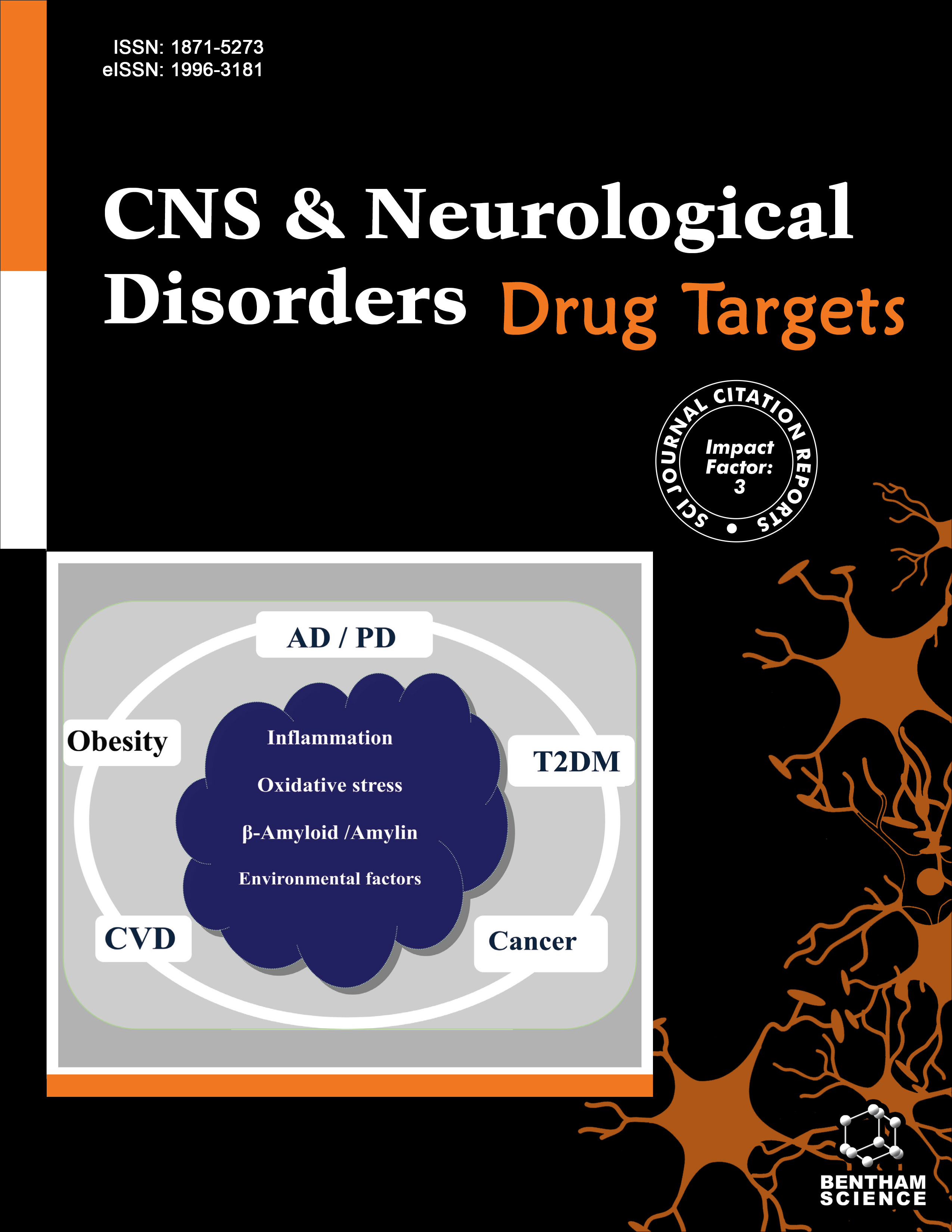- Home
- A-Z Publications
- CNS & Neurological Disorders - Drug Targets (Formerly Current Drug Targets - CNS & Neurological Disorders)
- Previous Issues
- Volume 20, Issue 9, 2021
CNS & Neurological Disorders - Drug Targets (Formerly Current Drug Targets - CNS & Neurological Disorders) - Volume 20, Issue 9, 2021
Volume 20, Issue 9, 2021
-
-
Cellular Senescence and ApoE4: Their Repercussions in Alzheimer’s Disease
More LessAlzheimer’s Disease (AD) is characterized by progressive memory loss due to neurodegeneration that occurs mainly during aging. The accumulation of senescent cells has been related to aging. Furthermore, the expression of the variant ApoE ε4 is a critical risk factor for AD. Some events that occur in senescence, such as the secretion of pro-inflammatory molecules, and metabolic and epigenetic changes, in additio Read More
-
-
-
Highlighting the Protective or Degenerative Role of AMPK Activators in Dementia Experimental Models
More LessAuthors: Marjan Nikbakhtzadeh, Fatemeh Shaerzadeh and Ghorbangol AshabiAMP-activated protein kinase (AMPK) is a serine/threonine kinase and a driving or deterrent factor in the development of neurodegenerative diseases and dementia. AMPK affects intracellular proteins like the mammalian target of rapamycin (mTOR) Peroxisome proliferator-activated receptor-γ coactivator 1-α (among others) contributes to a wide range of intracellular activities based on its downstream molecules suc Read More
-
-
-
Immunotherapies for Parkinson’s Disease: Progression of Clinical Development
More LessAuthors: Jet S. Teng, Yin Yin Ooi, Soi Moi Chye, Anna P. K. Ling and Rhun Yian KohParkinson’s disease is a common neurodegenerative disease affecting the movement and well-being of most elderly. The manifestations of Parkinson’s disease often include resting tremor, stiffness, bradykinesia, and muscular rigidity. The typical hallmark of Parkinson’s disease is the destruction of neurons in the substantia nigra and the presence of Lewy bodies in different compartments of the central nervous system Read More
-
-
-
The Link between Exercise and Homocysteine in the Alzheimer’s Disease: A Bioinformatic Network Model
More LessElevated peripheral expression of homocysteine (Hcy) is associated with an increased risk of coronary heart disease and stroke, diabetes, and cancer. It is also associated with cognitive impairment as it has been reported that high levels of Hcy cause cognitive dysfunction and memory deficit. Among several etiological factors that contribute to the pathogenesis of neurodegenerative diseases, including Alzheimer’s disea Read More
-
-
-
GluN2B/N-methyl-D-aspartate Receptor Antagonists: Advances in Design, Synthesis, and Pharmacological Evaluation Studies
More LessAuthors: Vinod Ugale, Ashish Dhote, Rushikesh Narwade, Saurabh Khadse, P. N. Reddy and Atul ShirkhedkarSelective GluN2B/N-methyl-D-aspartate receptor (NMDAR) antagonists have exposed their clinical effectiveness in a cluster of neurodegenerative diseases, such as epilepsy, Alzheimer’s disease, Parkinson’s disease, pain, and depression. Hence, GluN2B/NMDARs are considered to be a prospective target for the management of neurodegenerative diseases. Here, we have discussed the current results and significance of Read More
-
-
-
Migraine and Obesity: Is There a Relationship? A Systematic Review and Meta-Analysis of Observational Studies
More LessAuthors: Mahsa Hatami, Neda Soveid, Azadeh Lesani, Kurosh Djafarian and Sakineh Shab-BidarBackground and Objective: Many studies have evaluated the risk of migraine headache in obese persons, suggesting controversial conclusions. The aim of this systematic review and meta- analysis of the observational studies was to clarify the association between migraine and obesity. Methods: Scopus and PubMed electronic databases were systematically searched up to February 2019 for observational studies providing data de Read More
-
-
-
Liver-Brain Axis in Sporadic Alzheimer’s Disease: Role of Ten Signature Genes in a Mouse Model
More LessAuthors: Ruchi Jakhmola-Mani, Anam Islam and Deepshikha P. KatareAim: Poor nutritional effect of junk food induces injuries to the liver and the brain but still most of the developing nations survive on these diets to compensate for the fast-paced lifestyle. The aim of the study is to infer the protein-connections behind the liver-brain axis and identify the role of these proteins in causing neurodegenerative disorders. Background: Chronic consumption of fructose and fat-rich food works as a toxin Read More
-
Volumes & issues
-
Volume 24 (2025)
-
Volume 23 (2024)
-
Volume 22 (2023)
-
Volume 21 (2022)
-
Volume 20 (2021)
-
Volume 19 (2020)
-
Volume 18 (2019)
-
Volume 17 (2018)
-
Volume 16 (2017)
-
Volume 15 (2016)
-
Volume 14 (2015)
-
Volume 13 (2014)
-
Volume 12 (2013)
-
Volume 11 (2012)
-
Volume 10 (2011)
-
Volume 9 (2010)
-
Volume 8 (2009)
-
Volume 7 (2008)
-
Volume 6 (2007)
-
Volume 5 (2006)
Most Read This Month
Article
content/journals/cnsnddt
Journal
10
5
false
en

Most Cited Most Cited RSS feed
-
-
A Retrospective, Multi-Center Cohort Study Evaluating the Severity- Related Effects of Cerebrolysin Treatment on Clinical Outcomes in Traumatic Brain Injury
Authors: Dafin F. Muresanu, Alexandru V. Ciurea, Radu M. Gorgan, Eva Gheorghita, Stefan I. Florian, Horatiu Stan, Alin Blaga, Nicolai Ianovici, Stefan M. Iencean, Dana Turliuc, Horia B. Davidescu, Cornel Mihalache, Felix M. Brehar, Anca . S. Mihaescu, Dinu C. Mardare, Aurelian Anghelescu, Carmen Chiparus, Magdalena Lapadat, Viorel Pruna, Dumitru Mohan, Constantin Costea, Daniel Costea, Claudiu Palade, Narcisa Bucur, Jesus Figueroa and Anton Alvarez
-
-
-
- More Less

